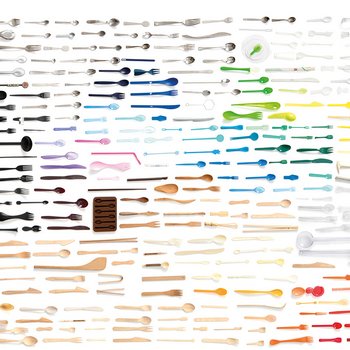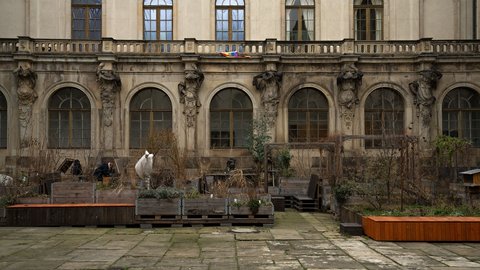
Der Garten im Hof des Japanischen Palais im Winter
© Staatliche Kunstsammlungen Dresden, Foto: Jacob Franke
While winter is in its last throes and the garden is notoriously barren in the cold season, we focus on the most important and at the same time most inconspicuous part of the garden: the soil. This is where the magic happens, which in summer months shows itself as a full splendor of shapes, colors, scents and tastes in the 'Edible Museum'. But what does a healthy soil need to provide the plants with everything they need?
For this, it should be loose and rich in nutritious humus, but ideally also capable of absorbing and storing water effectively. Earthworms are probably the best-known actors that ensure a well-aerated soil and thus good water storage capacity. So let's take a look at our magic box - the worm compost: Here, special compost worms that target the upper organic layers decompose organic waste such as vegetable scraps or coffee grounds from the Palais Café as well as parts of dead plants and green cuttings from the garden into their constituent parts.
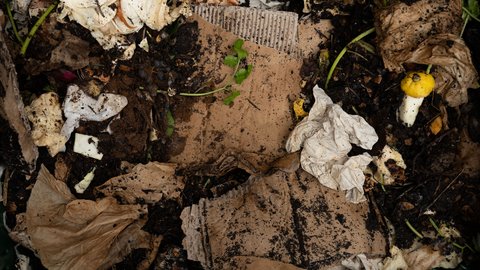
Wurmfutter
© Staatliche Kunstsammlungen Dresden, Foto: Jacob Franke
This creates humus, which contains plenty of nitrogen, phosphorus, potassium, calcium and magnesium. As a natural fertilizer, it provides the foundation for new growth and is supplied to the plants again in the form of fragrant soil. However, this work is not done by the worms alone, but also by many unknown, invisible microorganisms, microbes, bacteria and microfungi, which work in symbiotic teamwork to create one of the most important resources for climate protection. After all, what is produced by soil organisms in the garden of the Japanese Palace on a small scale is on a larger scale an answer to climate change: humus can store large amounts of carbon dioxide in the soil. The higher the humus content in the soil, the greater its storage capacity.
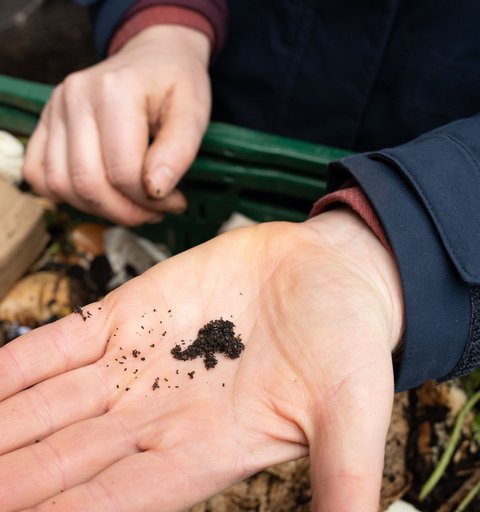
Recycling-Erde aus der Wurmkiste
© Staatliche Kunstsammlungen Dresden, Foto: Jacob Franke
Whether in the garden, on the balcony, in the basement or even in the apartment, it is quite easy to convert the accumulating organic waste directly into this black gold - a worm box can be easily built by yourself and if it is well maintained, it smells pleasantly of forest soil.
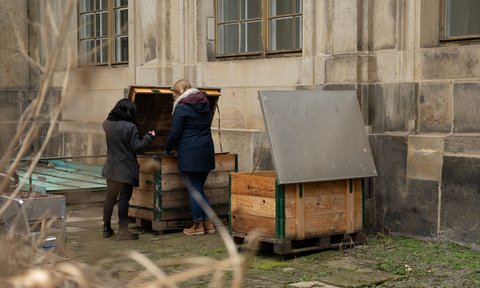
Wurmkisten im Palais-Garten werden inspiziert.
© Staatliche Kunstsammlungen Dresden, Foto: Jacob Franke
Also of interest:
What remains of us? Currently quite a lot. In her film collage "Die Hüter des Unrats - eine kurze Geschichte des Abfalls" (The Guardians of Garbage - A Short History of Waste), which can currently be seen at the Japanisches Palais, Susann Maria Hempel takes a sarcastic look at the way we deal with waste and its ecological consequences. About the stomachs of predatory fish, chickens and giant tortoises as an archive.
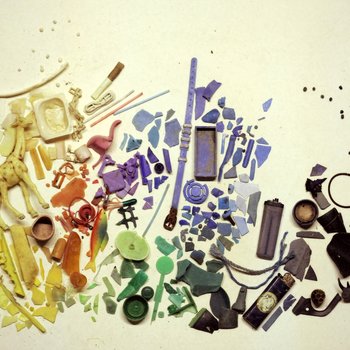
It is one of the most fascinating works at the Children's Biennale: Thijs Biersteker's installation "Wither". Yet the work has a more serious background. The delicate, semi-transparent artificial leaves light up in a rhythm that depicts the deforestation of the rainforest in the Amazon. How does this work? We asked the artist.
![[Translate to English:] Thijs Biersteker, Wither, 2022. Installation at Japanisches Palais, Dresden](/fileadmin/_processed_/a/5/csm_Abb03-wither-Thijs-Biersteker-Dresden_4ca3bb4580.jpg)
Disposable plastic cutlery is an icon of the global throwaway culture. It has been banned in the EU since July 3, 2021. Based on the collection of designers Peter Eckart and Kai Linke, the exhibition "Spoon Archaeology" at the Kunstgewerbemuseum explores this topic.
